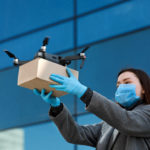With the severity of the COVID-19 impact outstripping all initial worse case scenario predictions, FINN editor-in-chief Alan Peaford asks “What’s next?”
Forget about learning the three Rs. The aviation and aerospace industry is now focusing on the two Rs – Re-launch and Recovery.
The industry has been stunned by the impact now being felt across the whole supply chain and by the airline industry around the world. Although there are signs of some form of recovery from east Asia, elsewhere around the globe there are hundreds of thousands of jobs being lost and fears that it could be several years before passenger numbers get back to anywhere near 2019 figures – or even, worse.
In the short-term, manufacturers from the largest OEMs right through the supply chain responded to the crisis by responding to the call by manufacturing parts and equipment to meet huge demands from the medical and health community.
UK’s chief executive of the aerospace, defence and security industry association ADS, Paul Everitt said: “They could take ideas, take drawings, take challenges, and then dedicate the engineering know-how to overcome them in relatively short order. It is this, along with rapid prototyping type skills that they have been able to bring to meet some of the challenges that we’ve seen.”
Winning passenger confidence will be the biggest challenge
The biggest challenge will be how to cope with a drop in demand as the virus is beaten back amid changing public perceptions and attitudes. Nick Harvey, regional director of recruitment consultants Intersearch said: “Most aviation organisations are ultimately paid for by the passenger, and that filters all the way down to to MROs, ground handling organisations airports and so on. There’s going to be a knock on, as the airline’s lose cash flow. A lot of business travellers who were used to jumping on an aeroplane to get to a meeting will review. But also, I believe that a lot of families, certainly in the short term, are going to review holiday plans where they’re taking a long holiday because of loss of income. And they may look at alternatives.”
Crisis gives airlines the opportunity to put their house in order
But what choice will the airline industry offer? The COVID-19 crisis has enabled airlines to start putting their respective houses in order. Shedding jobs, returning or scrapping aircraft that don’t fit the new world; cancelling orders and options. Governments have been called on to bail out the industry – the airline’s association IATA sees losses of more than $300billion for an industry that rarely makes a profit anyway.
If we take our minds back to pre-crisis (yes, there was a time) many of us sitting in conference hotel bars would often try and put the aviation world to rights. Mismanaged airlines performing as cash cows for governments – or their ministers; routes that just didn’t make sense; an industry built for the 1950s, with infrastructure from the 1960s, petty protectionism that meant countries the size of a large lake would have their own regulations and air traffic management system; ownership that was restricted in the main to domestic investors; pricing that meant the airline would run at a loss; cramped and uncomfortable conditions – the list goes on and on.
The days of low-cost flights may be over
IATA has said on the record that the price of air tickets will rise. Analysts have suggested the days of the low-cost budget airline may have gone (although to be fair, many have greater financial depth and smarter management than their flag-carrying legacy rivals.)
The Darwinism effect on the airline industry could see a failure of many, with others surviving through consolidation. There is a clear case for ending foreign ownership limits which were set up after the second world war crisis.
COVID-19 has struck during what could have been a golden age of flying. The global load factor was 82.6 per cent in 2019, according to IATA, while the average fuel burn of new commercial jet aircraft has been falling for at least the past three decades, developments that can largely be traced to periods of high oil prices in 2008 and 2012.
Peter Morris, Ascend by Cirium’s chief economist, said: “Before the turn of the century, oil prices moved within a $10-20 per barrel range, so even though fuel was a significant proportion then of an airline’s costs at 8-9 per cent, it wasn’t worth the aircraft manufacturers investing in the research and development, and producing new aircraft.”
Industry faces its “gravest crisis”
But what will investment in aircraft technology look like? If Boeing and Airbus sneeze, then it says the rest of the supply chain will catch a cold. For many, it could be fatal.
“One of the major risks for us is suppliers going bust,” Airbus CEO Guillaume Faury on his first quarter earnings call. The call itself offered grim news with a negative cashflow of $8.3 billion, almost 50 per cent drop in profit and 15 per cent cut in revenues. “This is the gravest crisis the aerospace industry has ever known,” Faury said.
Production has already been cut by a third with 6,000 workers placed on government furlough schemes. Airbus said there were likely to be further cuts and thousands more job losses in June.
Boeing too is suffering. Already reeling from the 737 Max grounding it has axed at least 10 per cent of its commercial aircraft employees with CEO David Calhoun warning shareholders that dividend payments would not be seen for years due to the massive drop off in demand for new aircraft. Calhoun reported a net loss of $641 million. Only 50 aircraft have been delivered in Q1 … and Q2 looks worse.
Boeing seeks US government bailout
Boeing is looking for the US government for some bailout funding – and focusing on its own domestic issues saw the company withdraw from the proposed commercial aircraft joint venture with Brazilian manufacturer Embraer.
The Brazilians have an impressive regional jet. Boeing was taking an 85 per cent stake in the E-jet programmes to enable it to compete with Airbus who now own the former Bombardier C-Series, now called the A220. The smaller, cost effective narrowbodies could be playing a more important role as that commercial air transport market readjusts.
Investment in electric technologies is mothballed
There are concerns over the environmental issues that had already been pressing the aviation industry. The carbon emissions reduction scheme (CORSIA) had been planned to take a baseline for an average emission for 2019-2020. That figure – with the lack of flying – is now much lower and therefore would be unattainable once flying begins again.
Another victim has been the electric aircraft prospects. Airbus and Rolls Royce have jointly decided to bring the E-Fan X demonstrator to an end. Grazia Vittadini, Airbus chief technology officer said: “As with all ground-breaking R&T projects, it’s our duty to constantly evaluate and reprioritise them to ensure alignment with our ambitions. These decisions are not always easy. But they’re undoubtedly necessary to stay the course.”
Rolls-Royce Paul Stein added: “As with all such leading-edge programmes, we constantly evaluate the best way forward and it has become clear to both parties that the actual requirement to carry out a test flight with all the elements integrated is not critical at this time. As an aircraft, E-Fan X was always designed to be a demonstrator only and never for actual use as a product in service.”
£58m ($78.25) had been granted by the UK government for the project via the Aerospace Technology Institute (ATI). The E-fan X will not be the last futures project to be snuffed out or pushed to a back burner – but it will not help aviation to fight those who will be pressing to reduce the prospects for a return to commercial flying.
Industry must look to a post-COVID world
The industry will – and must – look toward the Post-COVID world, and perhaps forget what the world used to be like. In the short term, during the re-launch, there will need to be ideas put in place to allow social distancing, if that is what it takes. Sometimes it is perception, rather than reality that matters.
Changes in airport procedures will be at the heart of the post-COVID world, as Angela Gittens, the head of the Airports Council International (ACI) said: “Health screening and/or certification is likely to become the new normal. Many different solutions are being deployed, and further work is required to determine the most efficient and effective best practices. This may also be the time to consider solutions for truly autonomous, hands-free passenger self-processing throughout the journey.”
John Holland-Kaye, CEO Heathrow Airport, agrees. “Until there is a cure or a vaccination, it is likely that travel between countries will only happen if each considers the other to be low risk, and to have similar high standards. So the aviation industry needs a common biosecurity standard for air travel, just as there is for airport security.”
Screening will help restore public confidence
Ascend Cirium’s Morris agrees this will be crucial. “The future of aviation remains with passenger operations, but public confidence is likely to be restored only when COVID-19 screening is readily available and can be promptly administered.
“One thing is certain, the global economy will be much smaller coming out of the pandemic and people’s ability and willingness to spend on air travel will shrink. Add to that the higher-cost burden airlines are expected to bear, and the days of cheap air travel could be over.”
“It could be that even if all the proximity concerns are solved, the supply side could get so badly damaged that whether or not people want to travel, there are no longer the wide range of suppliers (airlines) there any more, who will offer air travel at the price some passengers are willing to pay.”
For the aerospace supply chain, it is vital that people fly again and for confidence of the OEMs to invest in R&D and technology advances returns. For governments, it is equally vital – 10 per cent of global GDP comes from tourism alone. Much of that, particularly in the developing world is built on air transport; Some 65million jobs around the world are in the aviation/aerospace sector. According to IATA 25 million of those are at immediate risk of disappearing.
If air transport fails, the world economy fails
This week, I talked on a Zoom meeting with Sanjeev Gadhia, CEO of African cargo carrier Astral Aviation. In his native Kenya thousands of tonnes of fresh vegetables ordered by Europe are rotting at Nairobi because the passenger aircraft whose bellies are usually filled with perishable goods, are grounded. Freighters can cope with just 25 per cent of the demand.
If air transport fails the world economy will fail – and even worse people will die in numbers that will far exceed those from COVID-19.
Survival – re-launching and recovering – is critical for us all.

